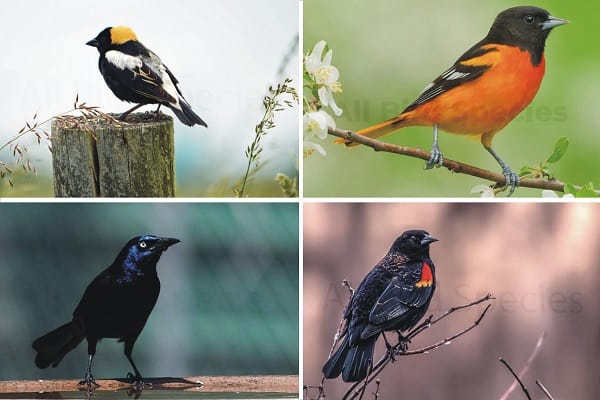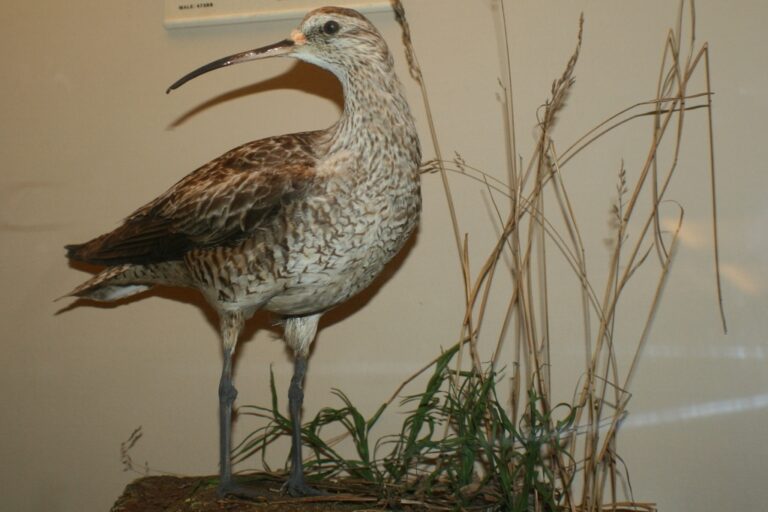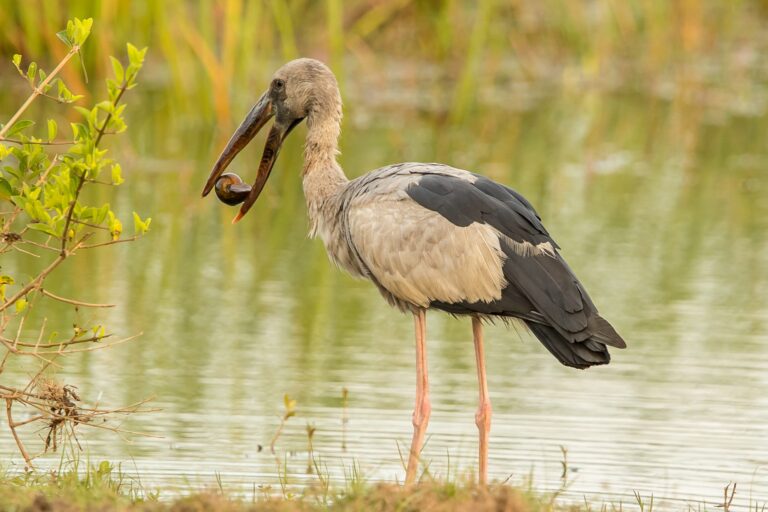16 Types Of Black Birds in Michigan (ID Guide With Pictures)
Black birds in Michigan are quite common, and you might have already seen a few of them without even noticing. This article aims to give you an overview of the different types of blackbirds and their distinctive characteristics so that you can identify them on your next bird-watching excursion.
Introduction to Black Birds Of Michigan (Small and Large species)
Michigan is home to many bird species. This makes it exciting for bird lovers. Black birds are special because of their interesting ways and how they help the environment.
Michigan has many birds because of its different places. You can see birds in wetlands and forests, and black birds do well in both cities and the countryside.
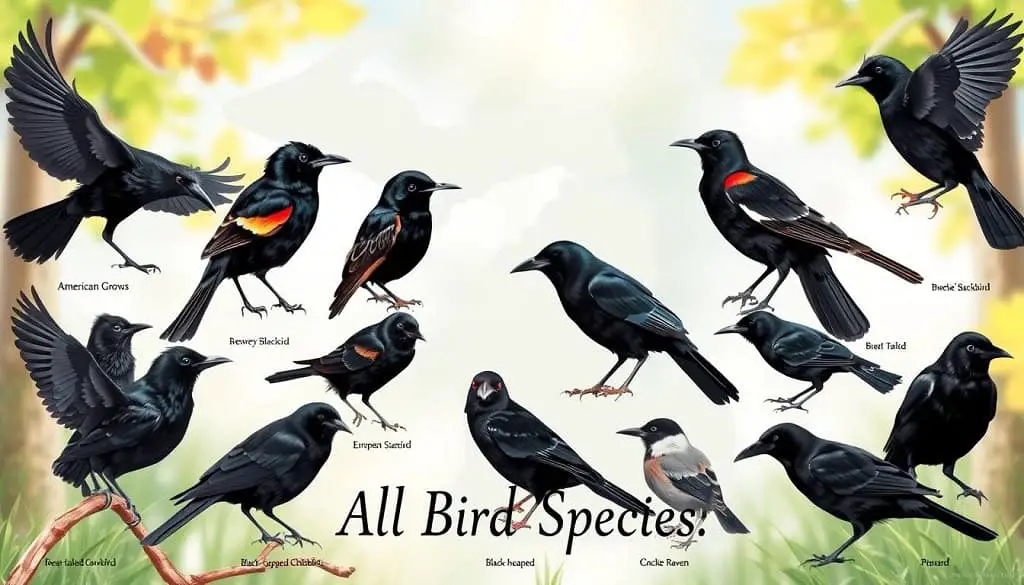
Why Black Birds Are Interesting
Black birds stand out because of their bright colors and unique sounds. They live in groups and talk to each other in interesting ways. Birdwatchers love watching them because they are so good at surviving.
The Importance of Black Birds in Michigan’s Ecosystem
Michigan black birds are important for environment. They help control pests and spread seeds. This helps plants grow strong.
By watching how black birds act, we learn how they help the environment. They play a big role in keeping nature in balance.
Here I’ll Explore 16 Black Bird Species Found In Michigan (Common & Rare)
1. Common Grackle
The common grackle is a stunning bird in the black birds family. It has shiny black feathers that look amazing in sunlight. Its black bird appearance makes it a favourite among bird lovers.

Appearance:
The common grackle’s feathers are not just black. They shine in different ways depending on the light. Males are bigger than females, making their feathers even more striking.
Habitat:
Common grackles live in many places. They like suburban areas, farmlands, and open woods. They are good at living near people and finding food easily.
Diet: Insects, Grains, and Small Mammals
These black birds with blue heads in Michigan eat many things, including insects, grains, and small mammals. It’s good at finding food, which can sometimes bother farmers.
Fun Fact: Known for Its Aggressive Behavior Around Feeders
Common grackles are bold and sometimes mean around bird feeders. They like to take over feeders and can be very territorial. Their social ways make them interesting to watch.
2. Red-winged blackbird
The red-winged blackbird is a key part of North American wetlands. It fascinates bird watchers and nature lovers with its bright colors and distinctive sounds.
It plays a big role in its home. This makes it interesting to watch.

Male vs. Female: Identification Differences
Looking at differences male vs female red-winged blackbirds shows a clear difference. Males have shiny black bodies with bright red and yellow patches. Females have brownish streaks on their feathers.
This makes it easy to tell males from females. Bird watchers can spot the difference right away.
Habitat:
Red-winged blackbirds live in wet places like marshes and swamps. They nest in thick plants. This helps their babies stay safe.
This habitat is good for many animals. It helps create a healthy environment.
Behavior:
Red-winged blackbirds like to sit on cattails. They show off their territory here, especially when they’re looking for a mate. This makes them easy to see.
Watching them helps us learn about their lives. It shows us how they interact with each other.
Vocalization:
The red-winged blackbird’s loud song is a sign of its presence. It uses the song to mark its territory and find a mate. Their songs fill the air in spring and summer.
3. European Starling
The European starling is a bird with shiny black feathers. It came to North America in the 1800s. People wanted to bring all birds from Shakespeare’s works here. Now, it lives in cities, farms, and woods, taking over from native birds.
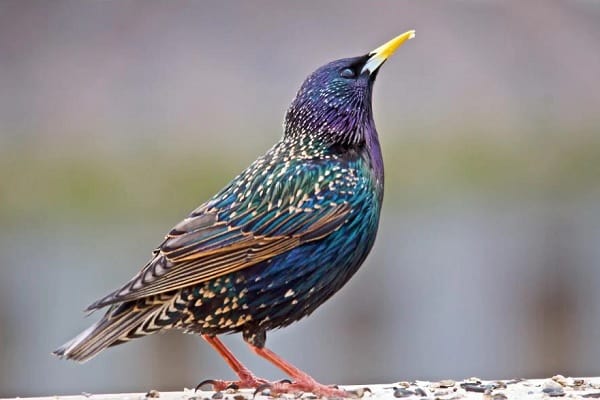
Appearance:
The European starling has black with speckled markings. Its shiny feathers catch the eye. It looks beautiful when it flies around.
Habitat:
This bird can live in many places. It likes cities and farms for food and homes. So, it’s seen all over North America.
Invasive Species
The invasive species history of the European starling is interesting. Since it arrived, it has taken over. It fights for homes and food, hurting native birds.
Behavior:
In winter, starlings fly together in huge groups. It’s a beautiful sight. But, their big groups can damage crops.
4. American Crow of Michigan
The American Crow is well-known in both rural and urban areas. It has black feathers and a strong bill. It lives in many places, from fields to forests, across the United States.

Appearance:
The American Crow has sleek black feathers and a strong bill. Its black color helps it blend in with its surroundings.
Habitat:
These birds live in forests, fields, and cities. They are good at living near people. This makes them easy to see for birdwatchers.
Intelligence:
The American Crow is very smart. They solve problems and use tools to find food. This shows how clever and adaptable they are.
Diet: Omnivorous Scavenger
They eat fruits, insects, and even dead animals, which helps keep the environment balanced and allows them to find food in different places.
| Aspect | Description |
|---|---|
| Appearance | All-black plumage with a stout bill |
| Habitat | Forests, fields, and urban areas |
| Intelligence | Notable for problem-solving abilities and tool use |
| Diet | Omnivorous, with a focus on scavenging |
5. Rusty Blackbird

The Rusty Blackbird is a migratory bird that passes through Michigan during the fall and spring. Its name comes from the rusty coloring seen in its plumage during the non-breeding season. Rusty Blackbirds are often found near wetlands, swamps, and marshes, where they forage for insects and other small prey in shallow waters. Unfortunately, this species has seen a dramatic population decline in recent years.
Since this blackbird is so rare, imagine what it would be like to treasure this rare natural beauty uniquely.
For example, Custom Necklaces. They can be carefully customized with high-quality materials to restore the mystery and elegance of the blackbird. Such a blackbird necklace is not only a reflection of personal hobbies and tastes but also a way to treasure good luck.
It is a meaningful gift whether for personal collection or given to relatives and friends who love nature.

These birds are migratory and mostly found in Michigan during the winter season. However, they can also be seen during their breeding seasons, which occur between March and June. Rusties, as some birders call them, are often found in wetlands, marshes, and swamps, where they forage for insects and berries.
| Common Name: | Rusty Blackbird |
|---|---|
| Scientific Name: | Euphagus carolinus |
| Length: | 8.3-9.8 in (21-25 cm) |
| Wingspan: | 14.6-16.5 in (37-42 cm) |
| Habitat: | Wetlands, marshes, and swamps |
| Diet: | Insects and berries |
| IUCN Red List Status: | Near-threatened |
Their dwindling population is likely due to habitat loss and degradation, so spotting one can be a rare and rewarding experience. Be sure to keep an eye out for these elusive birds on your next birdwatching trip in Michigan.
Related Article Duck Hunting in Michigan
Other Common Black Birds Species in Michigan
Besides the red-winged and rusty blackbirds, Michigan is also home to many other common blackbird species. These birds are easily recognizable due to their beautiful black feathers, and you can spot them throughout the state. Let’s take a closer look at some of these black birds:
| Common Name | Scientific Name | Key Characteristics |
|---|---|---|
| Common Grackle | Quiscalus quiscula | Large size, iridescent black feathers, yellow eyes |
| European Starling | Sturnus vulgaris | Short tail, shiny black plumage with white speckles, yellow bill |
| Brown-headed Cowbird | Molothrus ater | Small and stocky, brown head, dark eyes, iridescent black feathers |
| Baltimore Oriole | Icterus galbula | Black wings, orange underparts, distinctive black eye line |
| Orchard Oriole | Icterus spurius | Black wings, chestnut-colored underparts, white wing bars |
| Brewer’s Blackbird | Euphagus cyanocephalus | Long and slender, black feathers, bright yellow eyes |
| Shiny Cowbird | Molothrus bonariensis | Small and slender, metallic black plumage, yellow eyes |
| Bullock’s Oriole | Icterus bullocky | Black head, neck, and back, orange underparts, white wing bars |
These blackbird species are some of the most commonly spotted in Michigan, they all add to the beauty of Michigan’s natural landscapes. Be sure to keep an eye out for these magnificent birds on your next hike or outdoor excursion.
6. Brewer’s Blackbird
The brewer’s blackbird is special. It has shiny black feathers and a purple-green glow. It lives in many places in the United States. This bird is great at finding food in different places.
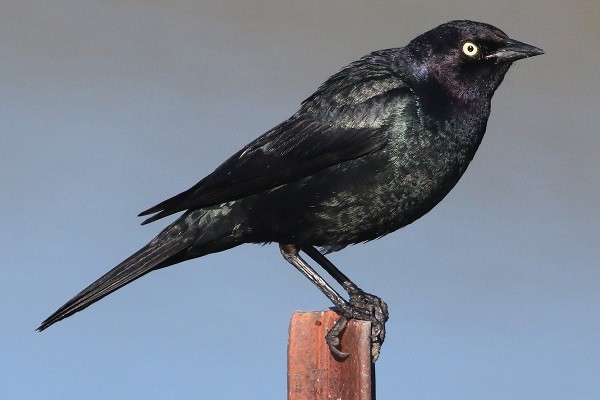
Appearance:
Males have shiny black feathers that look purple and green. Females are darker, with brown or gray feathers. This helps us tell males and females apart.
Habitat:
The brewer’s blackbird lives in many places. It likes grasslands, marshes, and even cities. It can be found in parks and open areas. This lets it live in many different places.
Social Behavior:
This bird likes to be with others. It forages in groups, especially when it’s not breeding. Being together helps it find food and stay safe.
Diet: Insects and Seeds
The brewer’s blackbird eats insects and seeds. It helps keep insects under control and spreads seeds. This is good for its home.
7. Brown-Headed Cowbird
The brown-headed cowbird is fascinating and misunderstood. It has a black body and a brown head. The cowbird lays its eggs in the nests of other birds, which can harm the birds whose nests it uses.
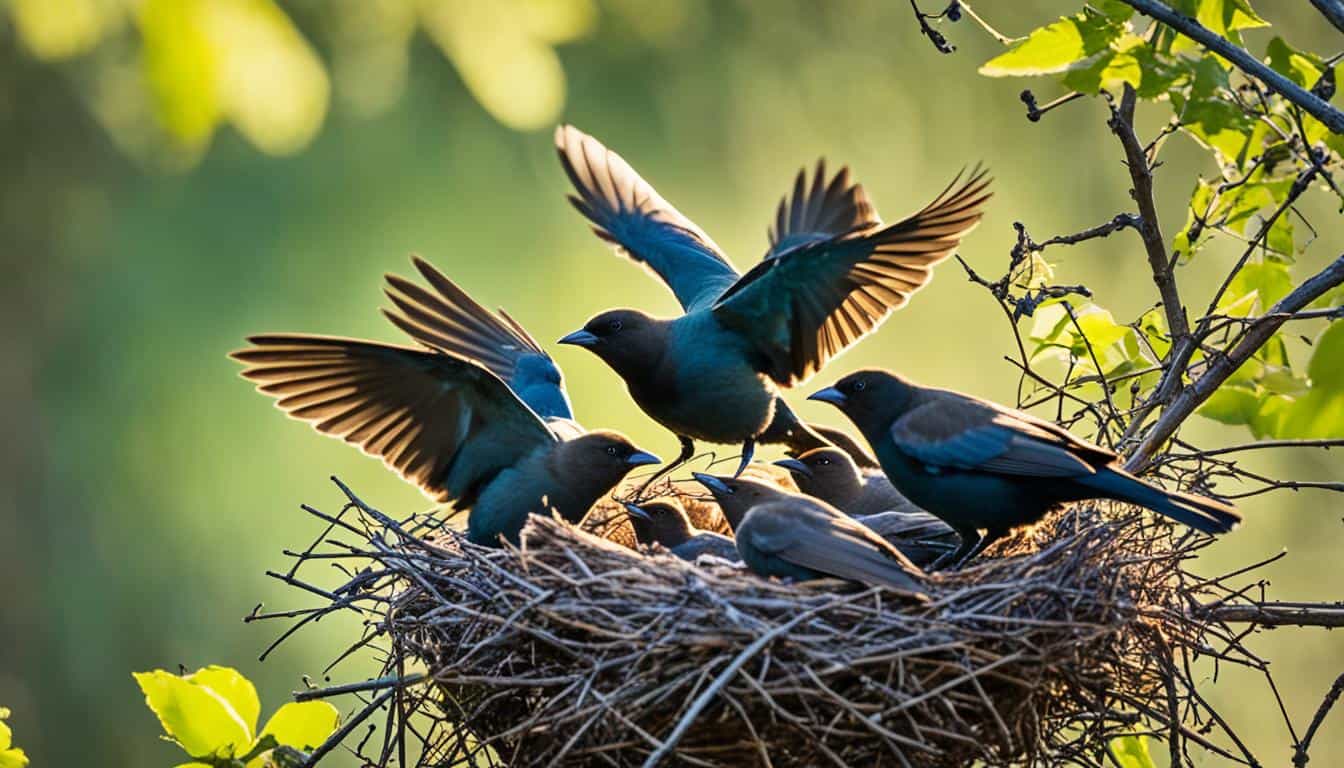
Appearance: Black Body with Brown Head
This bird is easy to spot because of its black body and brown head. Its colors help it fit in with different places, like open fields.
Unique Behavior: Lays Eggs in Other Birds’ Nests
The brown-headed cowbird uses other birds’ nests to raise its young. This means the host birds have to care for another chick. This can hurt the host birds’ own babies.
Habitat:
You can find brown-headed cowbirds in open fields, pastures, and suburbs. These places let them meet many host birds. They are good at living in many places, which means they can often lay eggs in other birds’ nests.
Impact on Other Species
The brown-headed cowbird’s actions can hurt other birds. When it lays eggs in other birds’ nests, it can make it harder for those birds to survive. This can change how birds live together in an area. Over time, it can even make some bird species fewer in number.
8. Fish Crow: Coastal Michigan Resident
The fish crow is a bird you can see in Michigan’s coastal areas. It’s smaller than the American crow. Its shiny black feathers help it live well by the sea.

Appearance:
The fish crow looks a lot like the American crow but is smaller. It has a sleek body and a short tail. Its bill is thinner, making it easy to tell apart.
Vocalization: Distinctive “Uh-Uh” Call
The fish crow’s call is unique. It sounds like “uh-uh” repeatedly. This call helps them talk to each other and mark their territory.
Habitat:
Fish crows live near water and wetlands. They like to be by the shore, estuaries, and marshes. This is where they find their food.
Diet:
Fish crows eat fish, crustaceans, and small sea creatures. They are skilled at finding food by the sea, which helps keep their homes healthy.
| Characteristic | Details |
|---|---|
| Size | Smaller than American Crow |
| Vocalization | Distinct “Uh-Uh” Call |
| Habitat | Water Bodies and Wetlands |
| Diet | Fish, Crustaceans, Small Aquatic Creatures |
9. Bobolink (yellow and black bird of michigan)
The bobolink is special among blackbirds. It has distinctive markings that catch the eye. Its black body is brightened by yellow and white, especially when it’s breeding.
It loves to be in farmland habitats. There, it searches for food and builds its nest.
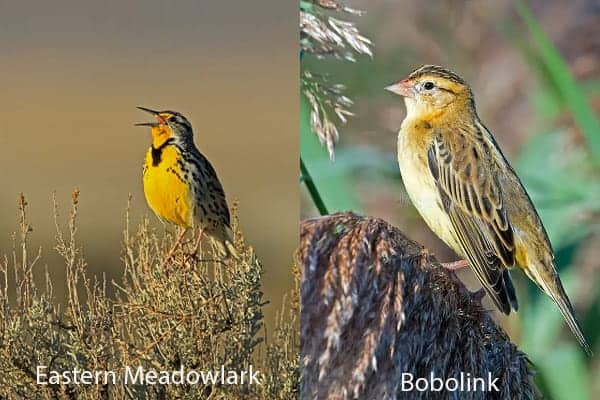
Appearance:
The male bobolink looks amazing in the breeding season. These yellow and black birds are also found in Michigan. This makes it stand out among other birds.
Habitat:
The bobolink loves open spaces, like farmlands. These places give it food and places to nest. You can see them in tall grass fields when they’re breeding.
Migration:
This bird goes on a big migratory journey. It travels from Michigan to South America for the winter. This shows how tough and adaptable the bobolink is.
Interesting Fact: One of the Longest Migratory Journeys of Any Songbird
The bobolink has one of the longest migrations of any songbird. It travels thousands of miles each year. This shows its strength and the big connections in nature.
10. Eastern Meadowlark
The eastern meadowlark is a bright bird that catches the eye. It has a yellow chest with a black “V” shape. This bird loves open fields and sings sweet songs in the spring.
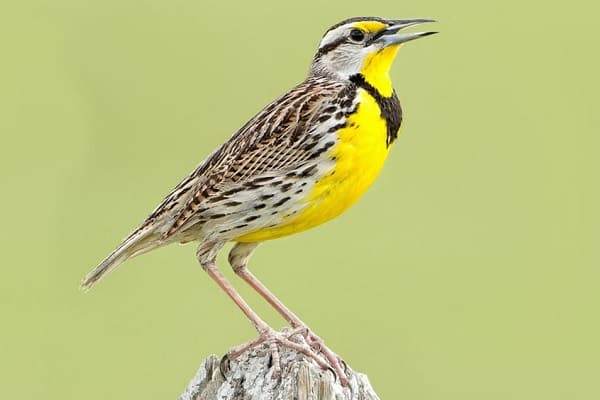
Appearance: Yellow Breast with Black “V” Marking
The eastern meadowlark’s yellow chest is striking. Its black “V” shape makes it look even more special. This color helps it hide from predators in the fields.
Habitat:
These birds live in big fields and grasslands. They find food like insects and seeds here. The open space helps them stay safe and find enough to eat.
Song:
The eastern meadowlark sings beautiful songs that sound like flutes. These songs help them find friends and mark their territory. Their songs are a big part of the fields’ beauty.
Behavior: Ground Forager
Eastern meadowlarks look for food on the ground. They eat seeds and insects. You can see them hopping and pecking at the ground, looking for food.
11. Orchard Oriole
The orchard oriole is a bird that catches the eye. It’s smaller than its blackbird cousins, and it has unique colors and behaviors that bird lovers enjoy.
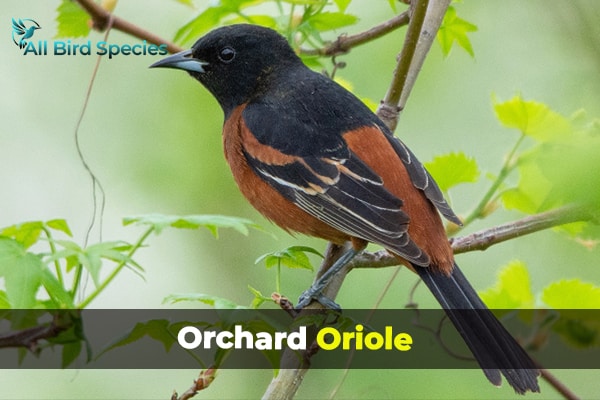
Appearance:
Males of this species have striking colors. They show off black and orange, with a rich burnt orange plumage. This makes them very pretty.
Habitat:
Orchard orioles live in orchards, open woodlands, and riverbanks. These places give them what they need to survive. They find food and places to nest here.
Behavior: Feeding on Nectar and Insects
These birds eat nectar and insects. This helps them live in different places. It shows how well they adapt to their surroundings.
Nesting: Builds Hanging Nests in Trees
Orchard orioles are known for their unique nests. They build hanging nests in trees, which keep the young safe and showcase the birds’ building skills.
12. Baltimore Oriole: Vibrant Yet Common
The Baltimore Oriole is a stunning blackbird. It has bright orange and black colors. You can see it in woodlands and homes in Michigan.

Appearance: Black with Bright Orange on Males
Males have bright orange feathers against black wings and back. Females are yellowish-orange. They are very colorful.
Habitat:
They live in open woodlands and near homes. They like places with fruit trees.
Diet: Primarily Fruit and Insects
They eat fruits and insects. They love berries and nectar. They also eat insects.
Migration:
They migrate to Central and South America for winter. This shows their amazing journey.
13. Yellow-Headed Blackbird
Yellow-headed blackbird is a bird you can’t miss. Its bright yellow head and chest, combined with a shiny black body, make it a favorite among birdwatchers who love to see it in the wild.

Appearance: Yellow Head and Chest
This blackbird is easy to spot because of its yellow head and chest. It looks amazing in marshes and wetlands. Its bright colors make it easy to see and enjoy.
Habitat:
The yellow-headed blackbird loves marshes and wetlands, which have lots of water plants and tall grass. It’s a great place to see these birds flying around.
Vocalization: Raspy, Harsh Calls
This bird makes loud, raspy sounds. Its calls add to the lively feel of wetlands. They use these sounds to talk to each other while they look for food or build nests.
Migration: Found in Michigan During the Summer Months
In the summer, yellow-headed blackbirds come to Michigan. They like the wetlands here because they have lots of food. Bird lovers get to see these birds when they are here.
14. Great-Tailed Grackle: Rare but Expanding
The great-tailed grackle is becoming more common in Michigan. These birds have long tails and bright colors. They like wet places to live.
More great-tailed grackles are showing up. This shows they can adapt and survive well.

Appearance: Large Blackbird with a Long Tail
Male great-tailed grackles have long, wedge-shaped tails. Their bodies shimmer in the light. Their yellow eyes make them look even more striking.
Habitat: Wetlands
Great-tailed grackles live in wet areas. These places are good for finding food. They also nest and socialize here.
Expansion:
You might see more great-tailed grackles in Michigan now. Their numbers are growing. They can live in different places.
Behavior:
Great-tailed grackles often live in big groups. They work together to find food. They can be aggressive when competing for food.
15. Double-Crested Cormorant
The double-crested cormorant is a strong bird. It has black feathers and an orange beak. It lives in water places like coasts, lakes, and rivers.
These large black birds of Michigan have sharp eyes and dive well. This makes it a problem for fishermen. It eats a lot of fish. Birdwatchers and fishermen often see them.

Appearance
The double-crested cormorant looks amazing. It has black feathers and an orange beak. This makes it easy to spot.
Habitat:
These birds live in different water places. They like coasts, lakes, and rivers, which help them find food, mainly fish.
Diet: Primarily Fish:
The double-crested cormorant mostly eats fish. They dive deep to catch fish.
Population:
Studies show more double-crested cormorants now. They are good at living in different places. This helps them thrive in many water areas.
16. Black-Billed Magpie
The black-billed magpie is a standout bird in North America. It has bold black and white feathers and a long tail. You can see these smart birds in open woodlands and farmlands.
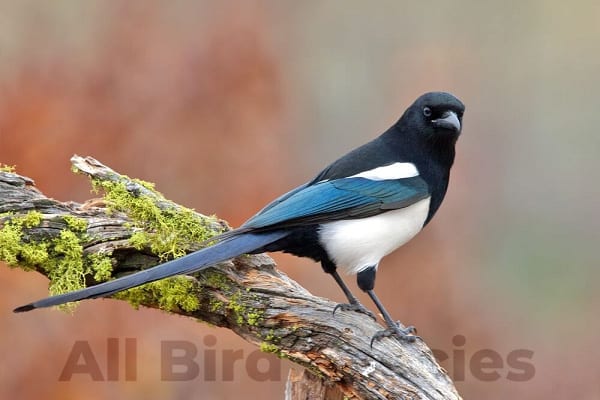
Appearance:
The magpie’s feathers are striking black and white, making it very beautiful. Its long tail makes it look even more elegant.
Habitat:
Black-billed magpies live in open woodlands and farmlands. These places help them find food and build nests. They can live in many different places.
Behaviour: Intelligent Scavenger
Black-billed magpies are very smart. They like to steal food from other animals, and because of their playful nature, they are fun to watch.
Diet: Omnivorous, Known to Steal from Other Animals
These birds eat many things like insects and small mammals. They even eat carrion. They are good at finding food, which helps them survive.
Frequently Asked Questions About Black Birds in Michigan
Q1: Do black birds migrate?
Yes, many species of blackbirds migrate seasonally.
Q2: What are the noisy black birds in Texas?
Common noisy blackbirds in Texas include the Great-tailed Grackle and Red-winged Blackbird.
Q3: Where do black birds migrate to?
Many migrate to warmer southern regions or coastal areas during winter.
Q4: Are black birds a nuisance?
They can be considered a nuisance in large numbers due to their noise and droppings.
Q5: What birds are native to Michigan?
Michigan is home to various native birds, including the American Robin, Blue Jay, and Red-winged Black birds.
Q6: Are black birds migrating now?
Migration patterns vary; check local birding reports for current activity.
Q7: Can you shoot blackbirds in Michigan?
Yes, in certain circumstances, but regulations vary; consult local laws.
Q8: What are the black birds in Michigan?
Common blackbirds in Michigan include the Common Grackle, Red-winged Blackbird, and European Starling.
Final Thoughts:
Black birds in Michigan are very important for the state’s ecosystems. Birds like the Common Grackle and Red-Winged Blackbird add color and life. They play key roles in food chains and help shape habitats.
Michigan has many places where birds can be seen, from wetlands to cities. Watching these birds helps you learn about them and their ways. It’s fun for anyone who loves birds or just likes nature.
Exploring Michigan’s nature helps you see how everything is connected. Seeing black birds reminds us to care for our planet, which will allow these amazing birds to live for many years.

